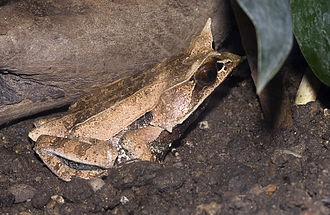Type the name of the breed you're looking for below
[wpdreams_ajaxsearchlite] Don't see the breed your're looking for? Click here and let us know!
Malayan Horned Frog
| Place of Origin and Range | The Malayan Horned frog or Malayan leaf frog is a species of frog restricted to the rainforest areas of southern Thailand and Peninsular Malaysia to Singapore, Sumatra and Borneo. However, records from Thailand to the Sunda Shelf may apply to another, possibly unnamed species. |
| Description | They are light to dark brown on the dorsal surface with varying patterns and camouflage very well with the forest floor. The throat is black-dark brown and diffuses into cream-yellow halfway along the ventral surface. The upper eyelids and snout are drawn out into long triangular projections, forming what looks like "horns", giving them their common name. There are two pairs of dorsolateral skin folds running down this species back. One pair starts behind the eye and ends near the groin, the other pair starts at corner of the eye and ends roughly halfway between the armpit and groin. The dorsum has randomly scattered, enlarged tubercles. Arms and legs are barred with skin folds and are mottled cream and different shades of brown. The toes are slightly webbed and the fingers are free from webbing. The tympanum is indistinct and the iris is golden brown. |
| Adult Size | Can grow up to 4 in (10 cm) |
| Accommodation | Unlike many amphibians, they do not require artificial heating. They need a large (at least ten-gallon) terrarium and do best with a substrate that will hold some humidity, such as commercial shredded bark or coconut husk bedding, or untreated topsoil on the floor of their terrarium. A shallow water dish should be included. Captive frogs should not be handled any more than necessary; when necessary, clean gloves should be worn. . A source of UV light is not required, and ambient temperature of 72 to 77 °F (22 to 25 °C) is sufficient. |
| Lifespan | Can live up to 10 years |
| Feeding / Diet | These frogs are insectivores, usually consuming flies, mosquitoes, and other small insects such as crickets. One study suggested the frog selects prey not by its size, but according to its activity level, with the most active prey being the most frequently eaten. |



